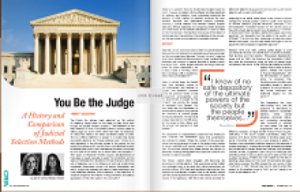 There is much controversy regarding the selection of judges and what system works best. Some would argue that “merit selection,” where candidates apply for approval by a committee and are appointed by the governor, is best, while others believe that the voters should choose judges. The Florida Bar defines “merit selection” as “[a] method for selecting judges solely on the basis of merit rather than through the popular election process.”[i] The implication of the Bar’s definition is that a competitive election process seeks to select judges by some criteria other than merit. By extension, no democratic election will select candidates based on merit. This is a difficult definition to accept in a society that favors democratic elections. As Thomas Jefferson said, “I know of no safe depository of the ultimate powers of the society but the people themselves; and if we think them not enlightened enough to exercise their control with a wholesome discretion, the remedy is not to take it from them, but to inform them with education.”[ii] Then again, as Alexander Hamilton argued, “[I]ndependence of the judges is equally requisite to guard the Constitution and the rights of individuals from the effects of those ill humors, which the arts of designing men or the influence of particular conjunctures sometimes disseminate among the people themselves; and which, though they speedily give place to better information and more deliberate reflection, have a tendency, in the meantime, to occasion dangerous innovations in the government, and serious oppressions of the minor party in the community.”[iii]
There is much controversy regarding the selection of judges and what system works best. Some would argue that “merit selection,” where candidates apply for approval by a committee and are appointed by the governor, is best, while others believe that the voters should choose judges. The Florida Bar defines “merit selection” as “[a] method for selecting judges solely on the basis of merit rather than through the popular election process.”[i] The implication of the Bar’s definition is that a competitive election process seeks to select judges by some criteria other than merit. By extension, no democratic election will select candidates based on merit. This is a difficult definition to accept in a society that favors democratic elections. As Thomas Jefferson said, “I know of no safe depository of the ultimate powers of the society but the people themselves; and if we think them not enlightened enough to exercise their control with a wholesome discretion, the remedy is not to take it from them, but to inform them with education.”[ii] Then again, as Alexander Hamilton argued, “[I]ndependence of the judges is equally requisite to guard the Constitution and the rights of individuals from the effects of those ill humors, which the arts of designing men or the influence of particular conjunctures sometimes disseminate among the people themselves; and which, though they speedily give place to better information and more deliberate reflection, have a tendency, in the meantime, to occasion dangerous innovations in the government, and serious oppressions of the minor party in the community.”[iii]
There is no question that one should select judges based on merit. However, consistent with the different priorities described by Jefferson and Hamilton, much controversy surrounds the question of which method of selection produces the most qualified, impartial, and responsible judiciary. Inevitably, choosing a judicial selection and retention method requires balancing different objectives and comparing relative strengths and weaknesses of the available alternatives. This article discusses the history of judicial selection, the evolution of the objectives of the process, and the arguments for and against the available methods.
You can find the article at CABA Briefs Summer 2012 on page 33
[i] Madison McClellan, Merit Appointment Versus Popular Election: A Reformer’s Guide to Judicial Selection Methods in Florida, 43 Fla. L. Rev. 529, 541 (1991) (citing Young Lawyers Division of the Florida Bar, Merit Retention of Judges Handbook 1976).
[ii] Id. at 545.
[iii] Peter Webster, Selection and Retention of Judges: Is There One “Best” Method, 23 Fla. St. U. L. Rev. 1, 2 (1995).
Related Articles:



